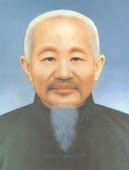 |
| Lauging Buddha or Mi Le' Hut |
The celestial Buddha named Hotei or Pu-Tai is best known as the jolly Laughing Buddha. In China, he is known as the Loving or Friendly One. He is based on an eccentric Chinese Ch'an (Zen) monk who lived over 1,000 years ago and has become a significant part of Buddhist and Shinto culture. Because of this monk's benevolent nature, he came to be regarded as an incarnation of the bodhisattva who will be Maitreya (the Future Buddha). His large protruding stomach and jolly smile have given him the common designation "Laughing Buddha."
The Laughing Buddha's image graces many temples, restaurants, and amulets, as he has become a deity of contentment and abundance. The image of Hotei is almost always seen carrying a cloth or linen sack (that which never empties) which is filled with many precious items, including rice plants (indicating wealth), candy for children, food, or the woes of the world. He is patron of the weak, poor and children.
 Laughing Buddha statues depict a stout, smiling or laughing bald man in robes with a largely exposed pot belly stomach, which symbolizes happiness, good luck, and plenitude. Some sculpture has small children at his feet. Another item that is usually seen with the Laughing Buddha figure is a begging bowl to represent his Buddhist nature.
Laughing Buddha statues depict a stout, smiling or laughing bald man in robes with a largely exposed pot belly stomach, which symbolizes happiness, good luck, and plenitude. Some sculpture has small children at his feet. Another item that is usually seen with the Laughing Buddha figure is a begging bowl to represent his Buddhist nature. In some scenes the Laughing Buddha may be found sitting on a cart drawn by boys, or wielding a fan called an oogi (said to be a "wish giving" fan -- in the distant past, this type of fan was used by the aristocracy to indicate to vassals that their requests would be granted). All of these images display Hotei as a wandering monk who goes around and takes the sadness from people of this world.
According to legend, if one rubs the Laughing Buddha's great belly, it brings forth wealth, good luck, and prosperity. Hotei is also referred to as the patron saint of restaurateurs, fortunetellers and bartenders. When one overeats or over drinks, friends jokingly attribute it to the Laughing Buddha's influence.









